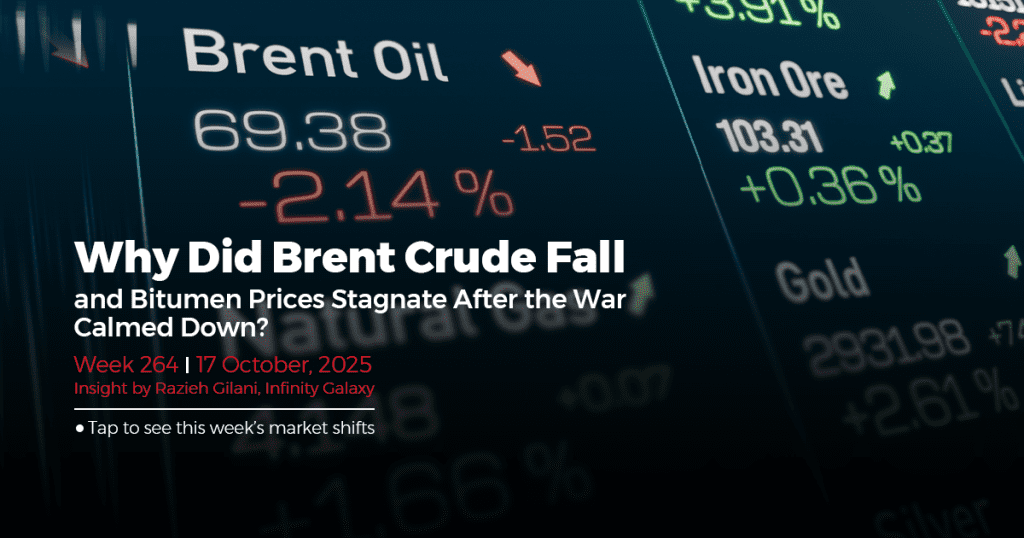Weekly Bitumen Report: Why Did Brent Crude Fall and Bitumen Prices Stagnate After the War Calmed Down?

The Political and Economic Developments of the Week
From the Middle East to Wall Street
On October 13, 2025, Donald Trump was in Egypt along with mediators from Egypt, Qatar, Turkey, and other partners and signed the Gaza ceasefire implementation document, officially announcing the end of the war. The agreement includes mechanisms for hostage and prisoner exchanges and monitoring frameworks; a phased implementation plan is still underway. The atmosphere of the ceremony was hopeful, yet major questions remain about the durability of the ceasefire and how the transition period will be managed.
Meanwhile, in the trade war, tension between Washington and Beijing rose this week with mutual port tariffs, threats of new duties, and disputes over critical mineral export restrictions. These shocks led to an unprecedented drop in the cryptocurrency market, around $380–400 billion was wiped off market capitalization within two days, and nearly $19 billion in positions were liquidated in just 24 hours.
On the Russia–Ukraine side, Moscow intensified drone and missile strikes on Ukraine’s energy infrastructure, causing massive blackouts, water outages, and emergency power restrictions in several regions. Ukraine expressed its urgent need for air defense systems as the war entered a harsh winter phase, causing fears of energy disruption in Europe.
Crude and Fuel Oil Markets in East Asia
A Return to Reality After the Ceasefire
Brent crude prices fell to around $62 per barrel in the week ending October 16, 2025, which is the lowest level in the last 3 months.
This drop was a result of three main factors:
- The Middle East ceasefire, which sharply reduced geopolitical risk and erased most of the “war premium” from the prices.
- An unexpected rise in U.S. commercial inventories, according to the EIA report, alongside OPEC+ producers returning to full supply after maintenance shutdowns.
- Considerable weak demand from Asia, especially China, which is involved with slow industrial growth and pressure of tariff war with America
Overall, the market has shifted from an emotional to a fundamental phase, focusing on high supply and weak consumption, setting the stage for a natural price correction.
Bitumen prices in Singapore and South Korea fell for the third consecutive week. Singapore bitumen prices dropped to $395-405 per ton, while South Korea declined to around $375. Seasonal demand in Southeast Asia has not risen yet, and the market faces excess export-ready cargo volumes.
Bitumen Market in Bahrain and Europe
Apparent Growth, Static Reality
Following last week’s mild growth, Mediterranean and Rotterdam FOB bitumen prices rose by about $12 and $4, respectively. However, this increase was driven more by fluctuations in heavy fuel oil than real demand growth. European bitumen now trades in the range of $370–420 per ton, while Bahrain’s price remains steady at $400 per ton for another quarter.
| Latest Market Prices (16 October 2025) | |
|---|---|
| Crude Oil | $62 |
| Singapore’s 180 CST | $370 |
| Singapore’s Bitumen | $395-405 |
| South Korea’s Bitumen | $375 |
| Bahrain’s Bitumen | $400 |
| Europe’s Bitumen | $370–420 |
India Bitumen Market
Temporary Stability Under Looming Downward Pressure
In India’s local market, there were no significant changes in prices, but the market players are highly concerned that weak demand from China and Singapore will soon apply downward pressure in India. Although road construction projects have started after the monsoon, Indian importers are lowering the offered prices unofficially.
China Market
Demand Still Asleep
After last week’s decline, East China’s bitumen market saw a slight improvement, but slow construction activity and lower import levels suggest that the demand has not yet recovered.
Most buyers purchase locally, and new orders are on hold, waiting for clearer market signals.
Market Analysis of Iran
Cautious Optimism Amid Demand Pressure
Over the past week, weak demand, falling oil prices, and exchange rate volatility in Iran have kept export pressure high, with buyers pushing prices downward for several consecutive weeks. Nevertheless, there is cautious optimism that the trend could reverse if market signals shift.
Insight by Razieh Gilani from Infinity Galaxy
It seems that the global bitumen market is transitioning from an emotional phase to a phase of realism. While the Middle East ceasefire has eased the market’s psychological atmosphere, the real drivers are not on the demand side but stem from oversupply and unstable trade policies.
The market is redefining its balance. The current fluctuations are signs of a return to rationality rather than signs of collapse.
If oil stabilizes between $60–65 per barrel and the ceasefire holds, we could see a gradual seasonal demand recovery by late October, particularly from East Africa and South Asia.
Talk to Our Bitumen Experts
At Infinity Galaxy, we’re here to answer any questions about buying bitumen. You can also check the latest bitumen prices by destination. Let us know your inquiry using the form below.
"*" indicates required fields






